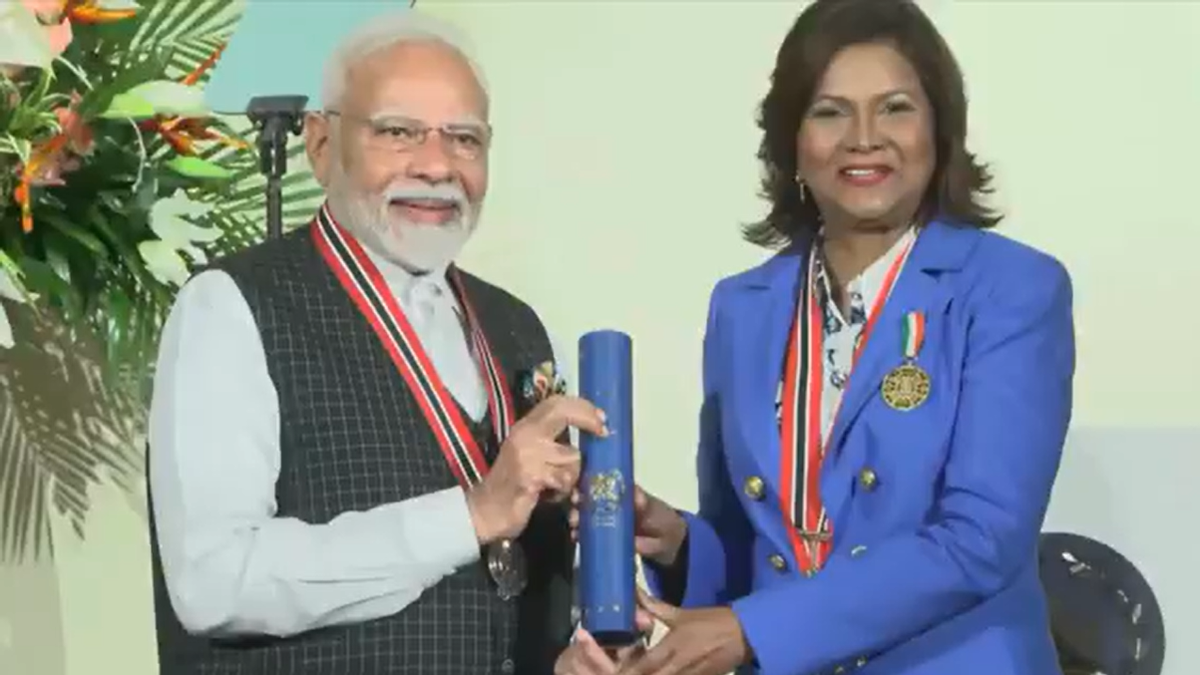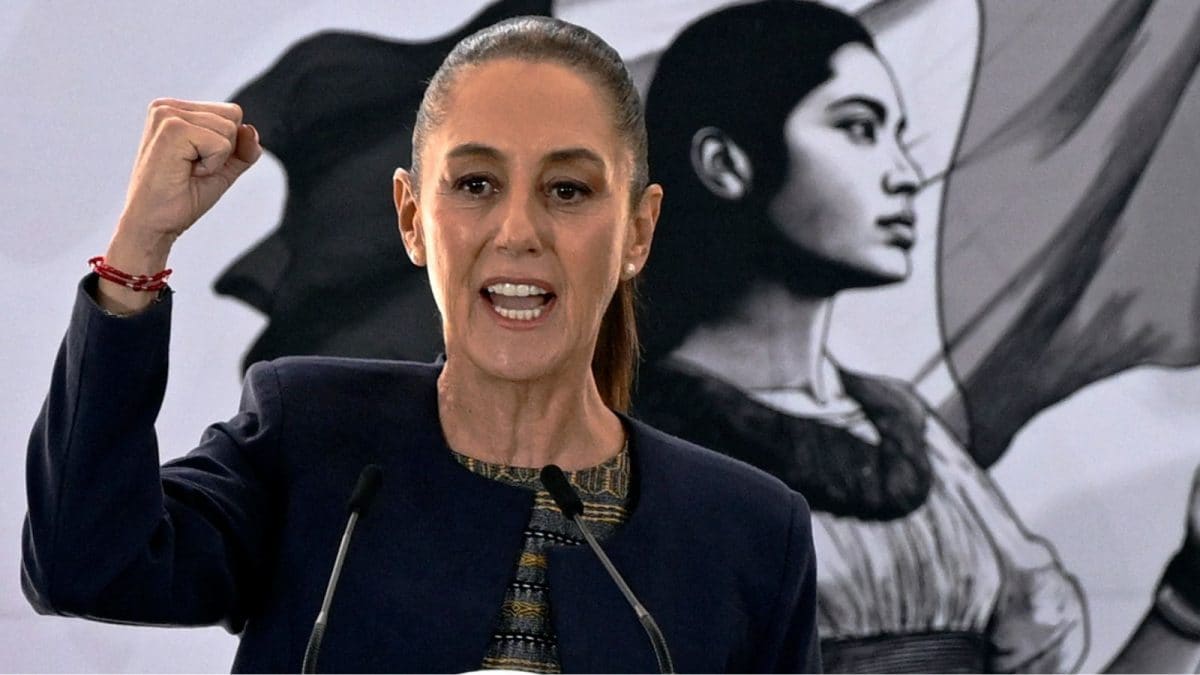When Prime Minister Narendra Modi landed in Port of Spain, the capital of Caribbean nation Trinidad and Tobaga, on Thursday (July 4, 2025) he was welcomed with a cultural performance of Chautaal, a Bhojpuri folk music form. His Trinidad and Tobago counterpart, Kamla Persad-Bissessar, traces her origins to Bihar. In the ceremonial dinner hosted by her for Mr. Modi, food was served on a Sohari leaf, again a staple in Bihari households. President Christine Carla Kangaloo is also from an Indo-Trinidadian family.
Also Read: Indian community’s journey in Trinidad and Tobago a courageous one: PM Modi
Bhojpuri Chautaal echoes in Trinidad & Tobago! pic.twitter.com/k2OBhPg7ch
— narendramodi_in (@narendramodi_in) July 3, 2025“A total of 13 lakh people live in this country, out of which 45 per cent are of Indian origin,” Randhir Jaiswal, Spokesperson Ministry of External Affairs, said during a media brief on the PM’s visit, adding, “Among the 45% of people... most are those who have come from Uttar Pradesh and Bihar. Most of these people are those who have come from Bhojpuri-speaking districts like Chhapra, Ara, Ballia, Siwan, Gopalganj, Banaras, Azamgarh, etc.”
India’s Caribbean connection
India’s connection with Caribbean nations dates back to 1845. Fath Al Razack, a ship carrying 225 labourers from colonial India landed at the Gulf of Paria marking the arrival of Indians to Trinidad. Subsequently over 1.4 lakh Indian labourers were sent to Trinidad, mostly from present day Uttar Pradesh and Bihar to work on the sugar plantations. A majority of them were Hindus and spoke Bhojpuri, Awadhi, and Hindi.
After slavery was officially abolished, the British came up with the Indian Indentured Labourers System under which people would “voluntarily” offer to work as plantation labourers. A number of Indians agreed and migrated to colonies as India was grappling with famine and poor economic conditions under Colonial rule. These Indians were refers as Girmitiyas, a colloquial term derived from English word ‘agreement’. The British transported several thousand Indian labourers to several of its colonies, including Mauritius, Fiji, Trinidad, and Guyana.
The British called it the Great Experiment, in which as many as 1.2 million Indians were migrated to several colonies between 1834 and 1920, according to the UNESCO. Though the agreement stated that these Indians would work “for a set period of time”, a majority of them chose to stay back by obtaining a new indenture. Some returned, only to bring back their families.
Another form of slavery?
The British called the Great Experiment a success, the Dutch too followed it and thus Suriname too became a destination for Girmitiyas. On paper, the system looked like a contract on paper, but it was no less than slavery. The indenture was not based on the principle of equality or natural justice, wrote Ambassador Bhaswati Mukherjee in an article published in the MEA website in 2014. The indentured were shipped to the Caribbean and confined to a plantation or estate where they lived and worked under conditions comparable to those for Africans under slavery. They had no choice in employer, could not change employers or buy themselves out of, or negotiate their contract, nor could they move freely without the consent of their employers, wrote Professor Kamala Kempadoo in the article ‘“Bound Coolies” and Other Indentured Workers in the Caribbean: Implications for debates about human trafficking and modern slavery’, published in Anti-Trafficking Review in 2017.

Archival photograph of some of the early East Indians in Trinidad and Tobago. Courtesy Kumar Mahabir | Photo Credit: The Hindu Photo Library
In an article published in The Hindu’s Sunday Magazine in 2017, when India observed 100 years of abolishment of indentured labour, author G. Pramod Kumar wrote: “compared to “slave” labour, indenture was projected as “free” labour, even though the workers were bonded by contract for five years under harsh conditions. ‘Double-cut’, for instance, would dock two days’ pay for a day’s absence from work.”
The workers could not easily move outside their estates. If caught without their ‘immigration ticket’, they were jailed for ‘vagrancy’. The colonisers wanted to appear morally right without losing profits, but what they had surreptitiously laid out was “a new system of slavery”, he wrote quoting Hugh Tinker’s seminal book published in 1974 titled A New System of Slavery.

Where are the women?
While it is a matter of pride for both Trinidad and India that two Indian-origin women are ruling the South American nation, very little is documented on women indentured labourers.
Professor Kamala Kempadoo wrote that Indian women were recruited not for their labour, but to marry, provide care work, bring stability to the male labour force, and help eliminate the cost of remigration and the loss of workers. “As wage labourers they were deemed inferior to men, and were paid less even while they performed the same work in the fields, but their sexuality was highly prized by the employers. The sexualisation of, in particular, Asian indentured women, is not dissimilar to that which is described as ‘sex trafficking’ in the twenty-first century, in that sexual labour was, and is, an explicit part of the reasons for the recruitment and overseas employment of women,” she wrote in the Anti-Trafficking Review article.
The Royal government even collected a £3 tax on indentured emigrants returning to their homeland, which was abolished in 1914 after the Smuts-Gandhi settlement of 1914.
Gandhiji’s Satyagraha against indentured labour
Mahatma Gandhi was a vocal critic of indentured labour. In his autobiography ‘My Experiments with Truth’, Gandhi recalled how Pandit Madan Mohan Malaviya sought permission to introduce a bill for the immediate abolition of the indentured labour system at the Imperial Legislative Council in February 1917, which was rejected. He then organised an all-India agitation against the system and met Lord Chelmsford, the then Viceroy of Colonial India. On July 31, 1971, the system was officially abolished.
Root search

Prime Minister of Trinidad and Tobago Kamla Persad-Bissessar during a visit to her ancestral village Bhelpur in Buxar district of Bihar. File photo. | Photo Credit: The Hindu Photo Library
Former indentured labourers and their decendants are still referred as Girmitiyas. In the Pravasi Bharatiya Diwas held in Bhubaneswar in January this year, Prime Minister Narendra Modi emphasised the need for study and research on Girmitiyas’ history. “Why cannot comprehensive database of Girmitiyas be created? This could document the villages and States they originated from, the destinations they settled in, and the journeys that shaped their lives,” he had remarked.
Trinidad Prime Minister Persad-Bissessar herself met her bloodlines in Bhelpur village in Bihar’s Buxar district, when she was on a state visit to India in 2012.
The government of Trinidad and Tobago maintains records of General Registers which contain details such as name, the name of the estate the Indians worked in, and the ship in which they the arrived. They also maintain records of Emigration Certificates, Estate Registers, Registers of Remittance to India, Marriages among others to help with root search. The Ministry of External Affairs runs Tracing the Roots programme to facilitate Indian origin people to find their bloodline in India.
While addressing Indian community members in Port of Spain Mr. Modi announced that citizens of Indian origin in Trinidad and Tobago, up to the sixth generation, will now be eligible for Overseas Citizen of India (OCI) cards, allowing them to live and work in India without restrictions. The government is also actively engaging with the community with Girmitiya conferences and root search. “Bring your children and neighbours. Bring anyone who enjoys ‘Chai’ and a good story. We will welcome all of you with open arms, warm hearts and Jalebi,” Mr. Modi added. Not just stories, the Indo-Trinidadian community has a rich history too to share.



.png)
.png)
.png)
















 4 hours ago
5
4 hours ago
5








 English (US) ·
English (US) ·